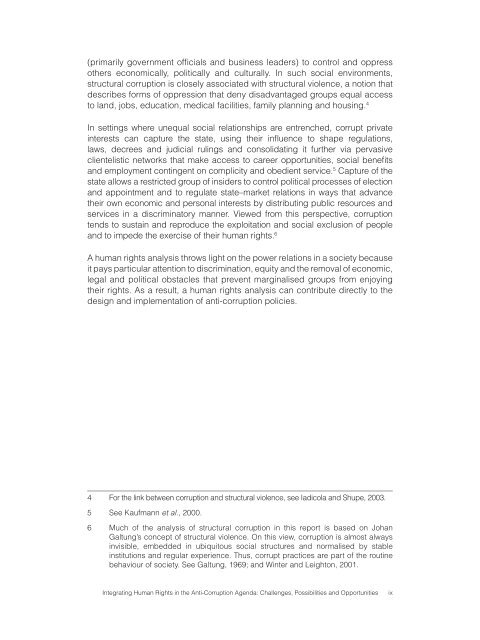Integrating Human Rights in the Anti-Corruption Agenda - The ICHRP
Integrating Human Rights in the Anti-Corruption Agenda - The ICHRP
Integrating Human Rights in the Anti-Corruption Agenda - The ICHRP
You also want an ePaper? Increase the reach of your titles
YUMPU automatically turns print PDFs into web optimized ePapers that Google loves.
(primarily government officials and bus<strong>in</strong>ess leaders) to control and oppress<br />
o<strong>the</strong>rs economically, politically and culturally. In such social environments,<br />
structural corruption is closely associated with structural violence, a notion that<br />
describes forms of oppression that deny disadvantaged groups equal access<br />
to land, jobs, education, medical facilities, family plann<strong>in</strong>g and hous<strong>in</strong>g. <br />
In sett<strong>in</strong>gs where unequal social relationships are entrenched, corrupt private<br />
<strong>in</strong>terests can capture <strong>the</strong> state, us<strong>in</strong>g <strong>the</strong>ir <strong>in</strong>fluence to shape regulations,<br />
laws, decrees and judicial rul<strong>in</strong>gs and consolidat<strong>in</strong>g it fur<strong>the</strong>r via pervasive<br />
clientelistic networks that make access to career opportunities, social benefits<br />
and employment cont<strong>in</strong>gent on complicity and obedient service. Capture of <strong>the</strong><br />
state allows a restricted group of <strong>in</strong>siders to control political processes of election<br />
and appo<strong>in</strong>tment and to regulate state–market relations <strong>in</strong> ways that advance<br />
<strong>the</strong>ir own economic and personal <strong>in</strong>terests by distribut<strong>in</strong>g public resources and<br />
services <strong>in</strong> a discrim<strong>in</strong>atory manner. Viewed from this perspective, corruption<br />
tends to susta<strong>in</strong> and reproduce <strong>the</strong> exploitation and social exclusion of people<br />
and to impede <strong>the</strong> exercise of <strong>the</strong>ir human rights. <br />
A human rights analysis throws light on <strong>the</strong> power relations <strong>in</strong> a society because<br />
it pays particular attention to discrim<strong>in</strong>ation, equity and <strong>the</strong> removal of economic,<br />
legal and political obstacles that prevent marg<strong>in</strong>alised groups from enjoy<strong>in</strong>g<br />
<strong>the</strong>ir rights. As a result, a human rights analysis can contribute directly to <strong>the</strong><br />
design and implementation of anti-corruption policies.<br />
For <strong>the</strong> l<strong>in</strong>k between corruption and structural violence, see Iadicola and Shupe, 2003.<br />
See Kaufmann et al., 2000.<br />
<br />
Much of <strong>the</strong> analysis of structural corruption <strong>in</strong> this report is based on Johan<br />
Galtung’s concept of structural violence. On this view, corruption is almost always<br />
<strong>in</strong>visible, embedded <strong>in</strong> ubiquitous social structures and normalised by stable<br />
<strong>in</strong>stitutions and regular experience. Thus, corrupt practices are part of <strong>the</strong> rout<strong>in</strong>e<br />
behaviour of society. See Galtung, 1969; and W<strong>in</strong>ter and Leighton, 2001.<br />
<strong>Integrat<strong>in</strong>g</strong> <strong>Human</strong> <strong>Rights</strong> <strong>in</strong> <strong>the</strong> <strong>Anti</strong>-<strong>Corruption</strong> <strong>Agenda</strong>: Challenges, Possibilities and Opportunities ix

















